How to Build a Product Qualified Pipeline in 2023
How to Build a Product Qualified Pipeline in 2023
How to Build a Product Qualified Pipeline in 2023
Learn what product qualified pipeline is and how to build one for your SaaS company. Also discover a tool that builds one for you.
Learn what product qualified pipeline is and how to build one for your SaaS company. Also discover a tool that builds one for you.
Learn what product qualified pipeline is and how to build one for your SaaS company. Also discover a tool that builds one for you.



Product qualified pipeline is a representation of all your users who have shown buying intent through product usage.
For many years, SaaS companies have had to rely on their sales managers to filter through leads galore and hope to convince a handful to purchase — essentially a “door-to-door salesman” approach.
This painstaking sales process often resulted in low sales pipeline coverage, annoyed prospects, and a grumpy sales team 🌩️.
Fortunately, product qualified pipeline offers another way!
In this article, we’ll discuss what product qualified pipeline is and why you should build one. Then we’ll cover the different pipeline stages and how to create product qualified pipelines that works.
Finally, we’ll introduce a one-of-a-kind tool for identifying product qualified leads and boosting conversion.
Let’s go!
What Is Product Qualified Pipeline?
To define product qualified pipeline, we need to understand what a product qualified lead (PQL) is.
A product qualified lead is a potential customer who:
✅ Tries your product (through a free trial or freemium plan.)
✅ Reaches the activation point (the moment in product usage when users think, “Aha! I understand the value of this product.”)
✅ Shows signs of purchase intent (e.g., regular use, inviting teammates, trying premium features).
✅ Fits your ideal customer profile (ICP).
How does this differ from a marketing qualified lead (MQL) or sales qualified lead (SQL)?
In a traditional sales pipeline:
Leads enter the sales funnel as MQLs. These leads have engaged with some of your inbound marketing and lead generation material but aren’t ready to purchase.
The marketing team nurtures MQLs with further inbound marketing and marketing automation until they become sales qualified leads, i.e., sales prospects that are more likely to buy.
Companies use lead scoring to identify SQLs. The sales managers then step in to attempt to make a sale.
Unfortunately, this lead scoring approach isn’t a perfect system, and the sales team may waste lots of time talking to leads who never convert.
Here’s where product qualified pipeline improves upon the sales process:
It’s built on the assumption that potential customers can “try before they buy.”
Lead qualification is based on in-app behavior, not marketing or website engagement.
The process is mostly self-service, with little direct sales activity from sales reps.
The focus is on product-led growth (PLG).
We think product-led growth rocks!

Let’s explore the benefits.
Four Reasons to Build Product Qualified Pipeline
If you’re a SaaS company with a rock-solid product, here’s why you should build product qualified pipeline:
1. High-Quality Leads
PQLs already know your product and its value. So, customers that need your product are coming right to you.
Like this:

You need leads in the sales funnel with high buying intent to hit your sales target.
You can study product usage data to identify a potential customer and send the right in-app messaging. (P.S. Here’s how)
The result?
Conversions galore and a win rate like never before! 🤑
2. Lower Churn Risk
When a lead is able to try your product for free, they can:
Explore the features and see how it suits their needs and goals
Develop workflows and habits
Incorporate the app in their business processes
So, the prospect isn’t likely to stop using the product. Meanwhile, MQLs and SQLs haven’t tried the product and are more likely to exit the sales funnel before purchasing.
3. Lower Acquisition Costs
People love free stuff!

A marketing qualified lead or sales qualified lead must be thoroughly convinced to buy without testing the product.
On the other hand, a sales manager doesn’t have to work as hard to get people to try your product for free. It’s also easier to get people to convert when they’ve experienced your product’s value.
The bottom line?
More conversions + less effort = a lower customer acquisition cost (CAC).
4. Faster Sales Cycle
Since product qualified pipeline is largely self-service, you can avoid much of the back-and-forth between the prospective customer and sales reps during the sales cycle. This will improve your sales velocity for a shorter average sales cycle length.
PQLs are well aware of their own needs. And they’re able to figure out how the product will help them.
If they like it, they’ll buy it – Simple!

You may be thinking, “Okay, I’m convinced! But what does product qualified pipeline look like?”
Like any pipeline, there are several identifiable sales pipeline stages for PQLs.
Five Stages of Product Qualified Pipeline
Product qualified pipeline can be broken down into the following stages, each representing a sales goal:
Stage 1: Attraction
This pipeline stage is mainly where the marketing team gets involved. You must prioritize lead generation and customer acquisition to get the product-led growth ball rolling.
Get the word out about your product via PLG marketing.
If all goes to plan, your ideal customer base will come flooding in to try your product!
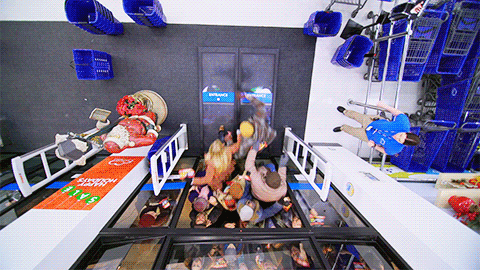
Stage 2: Activation
An activation moment is an in-app action that’s tightly linked with conversions. It will look different for every product.
Here are some examples:
Loom: Get one view on a Loom you created.
Grubhub: Enter your delivery address and view results for the area.
Twitter: Follow 30 people, with 1/3 of them following back.
Once you identify your activation point and see users reaching it – Congrats, you’ve got PQLs!
Stage 3: Adoption
In this sales stage, your leads start digging deeper into what the product can do in their workflows.
They show signs of commitment to your product, such as using it frequently and developing habits.
PQLs are considering whether they should purchase the premium product.
Stage 4: Conversion
By this sales pipeline stage, leads know if they want to purchase. So, all it takes is the right messaging at the right time to secure a deal.
For example, send in-app nudges when a prospective customer tries a premium feature or reaches the end of their trial period.
And BOOM! 💥 Your PQLs become paying customers.

Stage 5: Adoration
Well, you’ve made a sale. Pipeline’s over, right?

Nope! There’s still a sales opportunity ahead.
In this pipeline stage, you’re turning customers into ✨happy customers✨.
Keep watching your customer behavior data to see who’s using the heck out of your product.
Highly-engaged customers are a great source of positive reviews, high NPS scores, and solid customer feedback.
And the best part: They’re your top audience for upselling and cross-selling to bring in more expansion revenue.

This all sounds awesome! How do you set up these sales pipeline stages?
Let’s look into that next.
How to Build a Successful Product Qualified Pipeline
Here are the four steps you need to follow for effective PQL sales pipeline management:
Step 1: Define and Guide Activation
As a guideline, the activation milestone should be:
Highly predictive of conversion
Something you can track and influence
Easy for a lead to achieve early on in product usage
You can guide users to activate with a product tour and onboarding tactics like:
Personalization and segmentation
Self-service support
In-app nudges
Step 2: Automate Lead Qualification and Segmentation
Next, you need a way to qualify leads and group them by engagement level.
Why?
Well, a prospect requires different messaging in the activation stage (“Try this”) versus the conversion stage (“Buy now”).
Here’s the thing:
You can’t qualify all your leads manually. It might be doable for a small business, but it’s not scalable.

So, you need a tool that analyzes product usage data to qualify PQLs on your behalf. We’ll introduce you to a tool like this soon.
Step 3: Execute Outreach and GTM Strategies
It’s time to start communicating with your leads.
PLG is all about letting your product do the talking to secure a deal.
You might already have a GTM or sales automation app — like Hubspot or Salesforce — to handle customer outreach. You just need a way to integrate your new PQL pipeline 🤔.
Just wait until you hear about Toplyne.
Step 4: Keep Nurturing Converted Leads
Your paying customers are your bread and butter!

Continue providing excellent customer support and keep in touch about new features and upgrades.
This will do two things:
Minimize churn risk and create loyal customers.
Present more upselling and cross-selling opportunities.
Are you ready to hear about a revolutionary tool for PQL pipeline management that helps you convert like crazy? 🤪
Here it is.
Craft a Winning Product Qualified Pipeline with Toplyne
Toplyne is a one-of-a-kind tool, best described as a behavioral AI.
It fits right in with your existing tools – no change management or extra UIs required.
So, what does it do?
Toplyne’s AI works between your product analytics apps (e.g., Mixpanel, Amplitude) and your GTM sales apps (e.g., Salesforce, Hubspot).
It helps you build a high-functioning product qualified pipeline!
As a result, you can:
Increase your win rate
Identify more conversion and expansion opportunities
Boost your net retention revenue (NRR) and hit your sales goal
Let’s take a closer look at how the pipeline management process works in Toplyne, step-by-step.
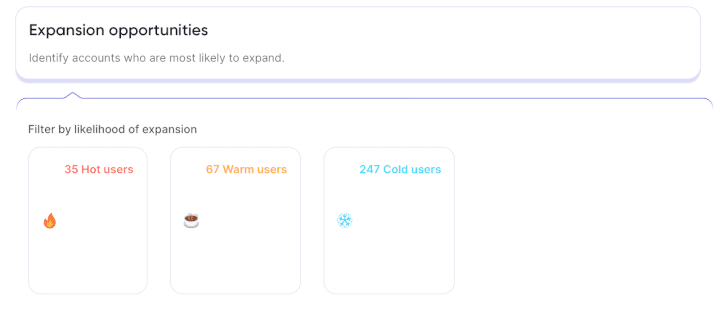
Know what this means?
You’ve identified your PQLs, just like that!
Step 2: Select Your Target Audience
Toplyne allows you to target either individual users or whole accounts.
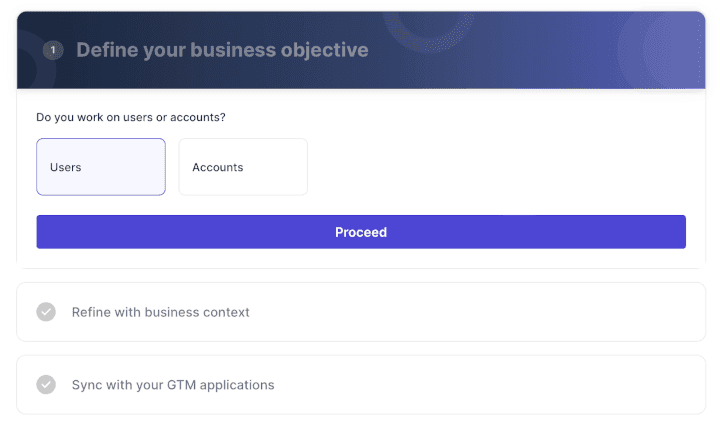
To narrow in further, you can choose to target:
All users: All your leads
Hot users: Leads who are very close to purchasing or upgrading
Warm users: Leads who have shown interest but aren’t ready to purchase or expand.
Cold users: Leads who show little to no interest in your product (Yet! 😉)
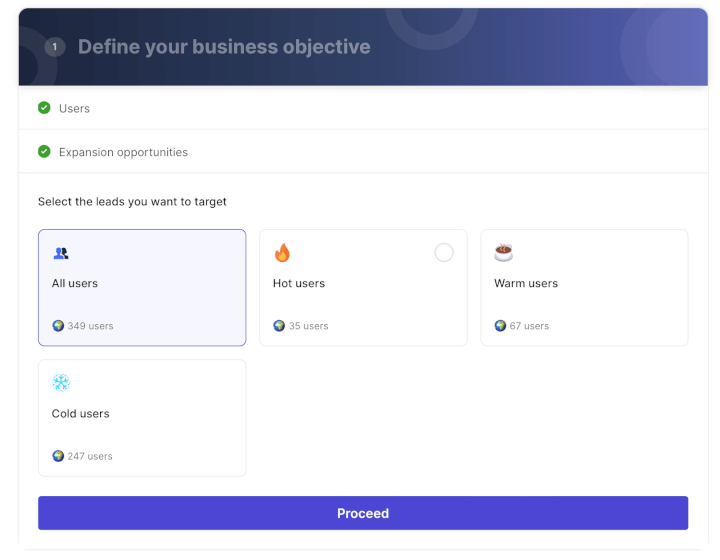
When it comes time for outreach, you can send nudges to hot users, encouraging them to try premium features. Or, you can reach out to cold users to encourage them to activate.
Step 3: Refining your Search
Toplyne allows you to get very granular about who you’re targeting with what actions.
First, you can filter sales prospects based on certain attributes and in-app actions. Toplyne reveals which ones are the strongest conversion indicators.

Next, you can narrow it down to your best leads by sales capacity, percentage, or a custom filter.
You can even create a control group to assess the impact and effectiveness of your outreach.
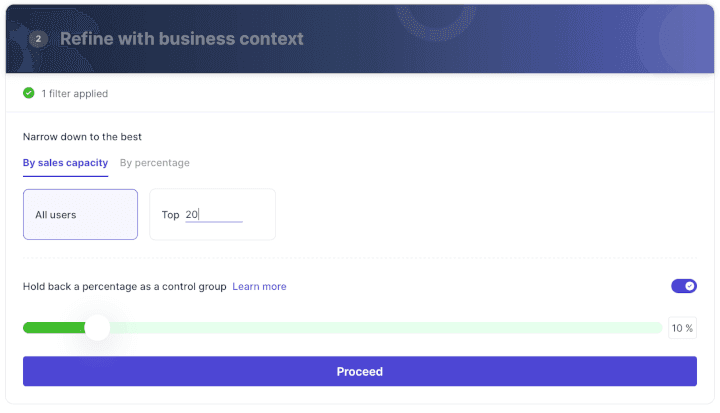
The control group will be held back while the test group is synced with GTM apps. Toplyne can then compare the performance metrics and tell you if your sales activity was effective based on the control.
Step 4: Sync your Product Qualified Pipeline with your GTM Apps
Here’s where the magic really happens! 🪄
By now, Toplyne has identified your pipeline! You now know which users are closest to converting and which need more guidance.
Additionally, you’ve created highly-focused groups to experiment with different GTM strategies.
All you need to do is sync your newly found PQLs with your chosen GTM or sales automation apps to start experimenting with outreach strategies.
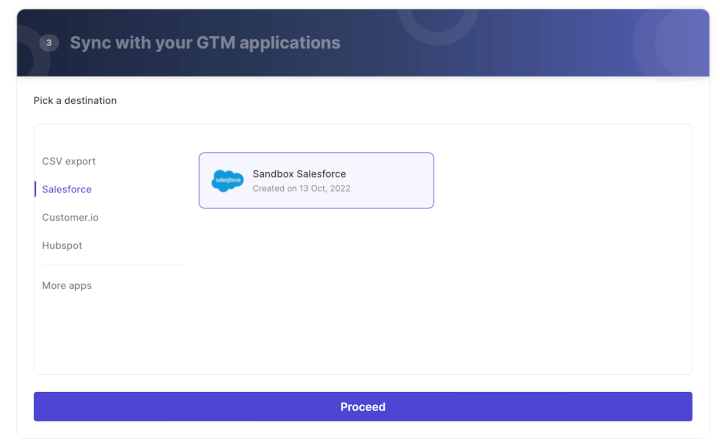
Toplyne integrates with Salesforce, Hubspot, PipeDrive, Appcues, and many more!
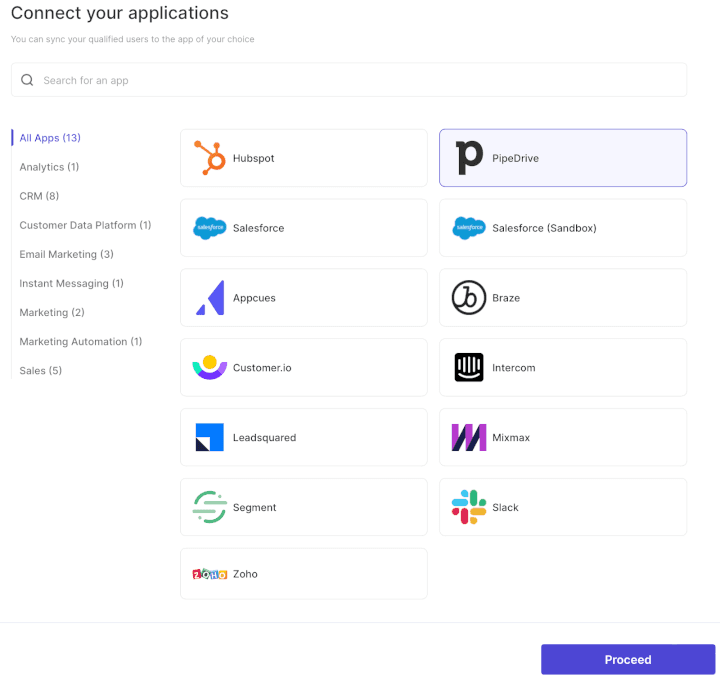
And if you’re not yet convinced, check out these results from Toplyne customers:
Pictory:
🔥14% increase in NRR
🔥38% increase in free-to-paid conversions
Gather:
🔥35% increase in pipeline coverage

Perfect Your Product Qualified Pipeline with Toplyne
You’ve got a product that works, so why hide its power?
Building product qualified pipeline allows users to experience your product’s value. You don’t have to convince them it’s good – you get to show them.
With product qualified pipeline, you can unlock benefits like:
😍 A large, highly-engaged user-base
💸 More conversion and expansion revenue
⌛ Time and money saved by letting your product shine
📈 Improved sales pipeline metrics like accelerated sales velocity and shorter average sales cycle length.
You can use Toplyne to help you make the most of every sales opportunity and smash every sales target. It allows you to set up a high-converting product qualified pipeline in a few easy steps.
And hey, let us show you! You can try Toplyne for free today to discover its value for yourself and become a sales leader 😎.
Product qualified pipeline is a representation of all your users who have shown buying intent through product usage.
For many years, SaaS companies have had to rely on their sales managers to filter through leads galore and hope to convince a handful to purchase — essentially a “door-to-door salesman” approach.
This painstaking sales process often resulted in low sales pipeline coverage, annoyed prospects, and a grumpy sales team 🌩️.
Fortunately, product qualified pipeline offers another way!
In this article, we’ll discuss what product qualified pipeline is and why you should build one. Then we’ll cover the different pipeline stages and how to create product qualified pipelines that works.
Finally, we’ll introduce a one-of-a-kind tool for identifying product qualified leads and boosting conversion.
Let’s go!
What Is Product Qualified Pipeline?
To define product qualified pipeline, we need to understand what a product qualified lead (PQL) is.
A product qualified lead is a potential customer who:
✅ Tries your product (through a free trial or freemium plan.)
✅ Reaches the activation point (the moment in product usage when users think, “Aha! I understand the value of this product.”)
✅ Shows signs of purchase intent (e.g., regular use, inviting teammates, trying premium features).
✅ Fits your ideal customer profile (ICP).
How does this differ from a marketing qualified lead (MQL) or sales qualified lead (SQL)?
In a traditional sales pipeline:
Leads enter the sales funnel as MQLs. These leads have engaged with some of your inbound marketing and lead generation material but aren’t ready to purchase.
The marketing team nurtures MQLs with further inbound marketing and marketing automation until they become sales qualified leads, i.e., sales prospects that are more likely to buy.
Companies use lead scoring to identify SQLs. The sales managers then step in to attempt to make a sale.
Unfortunately, this lead scoring approach isn’t a perfect system, and the sales team may waste lots of time talking to leads who never convert.
Here’s where product qualified pipeline improves upon the sales process:
It’s built on the assumption that potential customers can “try before they buy.”
Lead qualification is based on in-app behavior, not marketing or website engagement.
The process is mostly self-service, with little direct sales activity from sales reps.
The focus is on product-led growth (PLG).
We think product-led growth rocks!

Let’s explore the benefits.
Four Reasons to Build Product Qualified Pipeline
If you’re a SaaS company with a rock-solid product, here’s why you should build product qualified pipeline:
1. High-Quality Leads
PQLs already know your product and its value. So, customers that need your product are coming right to you.
Like this:

You need leads in the sales funnel with high buying intent to hit your sales target.
You can study product usage data to identify a potential customer and send the right in-app messaging. (P.S. Here’s how)
The result?
Conversions galore and a win rate like never before! 🤑
2. Lower Churn Risk
When a lead is able to try your product for free, they can:
Explore the features and see how it suits their needs and goals
Develop workflows and habits
Incorporate the app in their business processes
So, the prospect isn’t likely to stop using the product. Meanwhile, MQLs and SQLs haven’t tried the product and are more likely to exit the sales funnel before purchasing.
3. Lower Acquisition Costs
People love free stuff!

A marketing qualified lead or sales qualified lead must be thoroughly convinced to buy without testing the product.
On the other hand, a sales manager doesn’t have to work as hard to get people to try your product for free. It’s also easier to get people to convert when they’ve experienced your product’s value.
The bottom line?
More conversions + less effort = a lower customer acquisition cost (CAC).
4. Faster Sales Cycle
Since product qualified pipeline is largely self-service, you can avoid much of the back-and-forth between the prospective customer and sales reps during the sales cycle. This will improve your sales velocity for a shorter average sales cycle length.
PQLs are well aware of their own needs. And they’re able to figure out how the product will help them.
If they like it, they’ll buy it – Simple!

You may be thinking, “Okay, I’m convinced! But what does product qualified pipeline look like?”
Like any pipeline, there are several identifiable sales pipeline stages for PQLs.
Five Stages of Product Qualified Pipeline
Product qualified pipeline can be broken down into the following stages, each representing a sales goal:
Stage 1: Attraction
This pipeline stage is mainly where the marketing team gets involved. You must prioritize lead generation and customer acquisition to get the product-led growth ball rolling.
Get the word out about your product via PLG marketing.
If all goes to plan, your ideal customer base will come flooding in to try your product!

Stage 2: Activation
An activation moment is an in-app action that’s tightly linked with conversions. It will look different for every product.
Here are some examples:
Loom: Get one view on a Loom you created.
Grubhub: Enter your delivery address and view results for the area.
Twitter: Follow 30 people, with 1/3 of them following back.
Once you identify your activation point and see users reaching it – Congrats, you’ve got PQLs!
Stage 3: Adoption
In this sales stage, your leads start digging deeper into what the product can do in their workflows.
They show signs of commitment to your product, such as using it frequently and developing habits.
PQLs are considering whether they should purchase the premium product.
Stage 4: Conversion
By this sales pipeline stage, leads know if they want to purchase. So, all it takes is the right messaging at the right time to secure a deal.
For example, send in-app nudges when a prospective customer tries a premium feature or reaches the end of their trial period.
And BOOM! 💥 Your PQLs become paying customers.

Stage 5: Adoration
Well, you’ve made a sale. Pipeline’s over, right?

Nope! There’s still a sales opportunity ahead.
In this pipeline stage, you’re turning customers into ✨happy customers✨.
Keep watching your customer behavior data to see who’s using the heck out of your product.
Highly-engaged customers are a great source of positive reviews, high NPS scores, and solid customer feedback.
And the best part: They’re your top audience for upselling and cross-selling to bring in more expansion revenue.

This all sounds awesome! How do you set up these sales pipeline stages?
Let’s look into that next.
How to Build a Successful Product Qualified Pipeline
Here are the four steps you need to follow for effective PQL sales pipeline management:
Step 1: Define and Guide Activation
As a guideline, the activation milestone should be:
Highly predictive of conversion
Something you can track and influence
Easy for a lead to achieve early on in product usage
You can guide users to activate with a product tour and onboarding tactics like:
Personalization and segmentation
Self-service support
In-app nudges
Step 2: Automate Lead Qualification and Segmentation
Next, you need a way to qualify leads and group them by engagement level.
Why?
Well, a prospect requires different messaging in the activation stage (“Try this”) versus the conversion stage (“Buy now”).
Here’s the thing:
You can’t qualify all your leads manually. It might be doable for a small business, but it’s not scalable.

So, you need a tool that analyzes product usage data to qualify PQLs on your behalf. We’ll introduce you to a tool like this soon.
Step 3: Execute Outreach and GTM Strategies
It’s time to start communicating with your leads.
PLG is all about letting your product do the talking to secure a deal.
You might already have a GTM or sales automation app — like Hubspot or Salesforce — to handle customer outreach. You just need a way to integrate your new PQL pipeline 🤔.
Just wait until you hear about Toplyne.
Step 4: Keep Nurturing Converted Leads
Your paying customers are your bread and butter!

Continue providing excellent customer support and keep in touch about new features and upgrades.
This will do two things:
Minimize churn risk and create loyal customers.
Present more upselling and cross-selling opportunities.
Are you ready to hear about a revolutionary tool for PQL pipeline management that helps you convert like crazy? 🤪
Here it is.
Craft a Winning Product Qualified Pipeline with Toplyne
Toplyne is a one-of-a-kind tool, best described as a behavioral AI.
It fits right in with your existing tools – no change management or extra UIs required.
So, what does it do?
Toplyne’s AI works between your product analytics apps (e.g., Mixpanel, Amplitude) and your GTM sales apps (e.g., Salesforce, Hubspot).
It helps you build a high-functioning product qualified pipeline!
As a result, you can:
Increase your win rate
Identify more conversion and expansion opportunities
Boost your net retention revenue (NRR) and hit your sales goal
Let’s take a closer look at how the pipeline management process works in Toplyne, step-by-step.

Know what this means?
You’ve identified your PQLs, just like that!
Step 2: Select Your Target Audience
Toplyne allows you to target either individual users or whole accounts.

To narrow in further, you can choose to target:
All users: All your leads
Hot users: Leads who are very close to purchasing or upgrading
Warm users: Leads who have shown interest but aren’t ready to purchase or expand.
Cold users: Leads who show little to no interest in your product (Yet! 😉)

When it comes time for outreach, you can send nudges to hot users, encouraging them to try premium features. Or, you can reach out to cold users to encourage them to activate.
Step 3: Refining your Search
Toplyne allows you to get very granular about who you’re targeting with what actions.
First, you can filter sales prospects based on certain attributes and in-app actions. Toplyne reveals which ones are the strongest conversion indicators.

Next, you can narrow it down to your best leads by sales capacity, percentage, or a custom filter.
You can even create a control group to assess the impact and effectiveness of your outreach.

The control group will be held back while the test group is synced with GTM apps. Toplyne can then compare the performance metrics and tell you if your sales activity was effective based on the control.
Step 4: Sync your Product Qualified Pipeline with your GTM Apps
Here’s where the magic really happens! 🪄
By now, Toplyne has identified your pipeline! You now know which users are closest to converting and which need more guidance.
Additionally, you’ve created highly-focused groups to experiment with different GTM strategies.
All you need to do is sync your newly found PQLs with your chosen GTM or sales automation apps to start experimenting with outreach strategies.

Toplyne integrates with Salesforce, Hubspot, PipeDrive, Appcues, and many more!

And if you’re not yet convinced, check out these results from Toplyne customers:
Pictory:
🔥14% increase in NRR
🔥38% increase in free-to-paid conversions
Gather:
🔥35% increase in pipeline coverage

Perfect Your Product Qualified Pipeline with Toplyne
You’ve got a product that works, so why hide its power?
Building product qualified pipeline allows users to experience your product’s value. You don’t have to convince them it’s good – you get to show them.
With product qualified pipeline, you can unlock benefits like:
😍 A large, highly-engaged user-base
💸 More conversion and expansion revenue
⌛ Time and money saved by letting your product shine
📈 Improved sales pipeline metrics like accelerated sales velocity and shorter average sales cycle length.
You can use Toplyne to help you make the most of every sales opportunity and smash every sales target. It allows you to set up a high-converting product qualified pipeline in a few easy steps.
And hey, let us show you! You can try Toplyne for free today to discover its value for yourself and become a sales leader 😎.
Related Articles




Behavioral Retargeting: A Game-Changer in the Cookieless Era
Unlock the power of behavioral retargeting for the cookieless future! Learn how it personalizes ads & boosts conversions. #behavioralretargeting




All of Toplyne's 40+ Badges in the G2 Spring Reports
Our customers awarded us 40+ badges in G2's Summer Report 2024.




Unlocking the Full Potential of Google PMax Campaigns: Mastering Audience Selection to Double Your ROAS
Copyright © Toplyne Labs PTE Ltd. 2024
Copyright © Toplyne Labs PTE Ltd. 2024
Copyright © Toplyne Labs PTE Ltd. 2024
Copyright © Toplyne Labs PTE Ltd. 2024